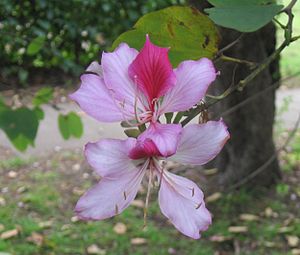Note: This is a project under development. The articles on this wiki are just being initiated and broadly incomplete. You can Help creating new pages.
Difference between revisions of "Bauhinia variegata - Kaancanara"
(→Common names) |
|||
| Line 12: | Line 12: | ||
==Common names== | ==Common names== | ||
{{Common names|sa=Kaancanaraka|en=Mountain Ebony|gu=Champakati, Kanchnar, Kachnar|hi=Kachanar, Kanchanar, Kachnar|kn= ಕಾಂಚನಾರ Kanchanaara, ಕಂಚುವಾಳ Kanchuvaala|ml=Chuvanna Mandharam|mr=Kanchana, Raktakancana|pa=Kanchnar|ta=Sigappu mandarai, Sihappu mantarai|te=Deva Kanchanam|mr=Kanchan, Kanchnar }} | {{Common names|sa=Kaancanaraka|en=Mountain Ebony|gu=Champakati, Kanchnar, Kachnar|hi=Kachanar, Kanchanar, Kachnar|kn= ಕಾಂಚನಾರ Kanchanaara, ಕಂಚುವಾಳ Kanchuvaala|ml=Chuvanna Mandharam|mr=Kanchana, Raktakancana|pa=Kanchnar|ta=Sigappu mandarai, Sihappu mantarai|te=Deva Kanchanam|mr=Kanchan, Kanchnar }} | ||
| + | <ref name="Common names"/> | ||
==Properties== | ==Properties== | ||
| Line 77: | Line 78: | ||
<ref name="Ayurvedic preparations">[https://easyayurveda.com/2012/12/26/kanchanara-bauhinia-variegata-uses-dosage-ayurveda-details/ Ayurvedic preparations]</ref> | <ref name="Ayurvedic preparations">[https://easyayurveda.com/2012/12/26/kanchanara-bauhinia-variegata-uses-dosage-ayurveda-details/ Ayurvedic preparations]</ref> | ||
<ref name="Chemical Composition">[https://www.researchgate.net/publication/272789736_Bioactive_Constituents_from_Bauhinia_variegata_Linn Chemical composition]</ref> | <ref name="Chemical Composition">[https://www.researchgate.net/publication/272789736_Bioactive_Constituents_from_Bauhinia_variegata_Linn Chemical composition]</ref> | ||
| − | + | <ref name="Common names">[https://sites.google.com/site/indiannamesofplants/via-species/b/bauhinia-variegata Common names]</ref> | |
<ref name="Cultivation details">[https://www.researchgate.net/publication/290591233_Propagation_of_Bauhinia_variegata_L_by_cuttings_and_seed Cultivation details]</ref> | <ref name="Cultivation details">[https://www.researchgate.net/publication/290591233_Propagation_of_Bauhinia_variegata_L_by_cuttings_and_seed Cultivation details]</ref> | ||
Revision as of 17:38, 17 June 2020
Kaancanara consists of the dried stem bark. It is a medium sized tree occurring in sub-Himalayan tract extending eastwards to Assam, Eastern, Central and South India. [1]
Contents
- 1 Uses
- 2 Parts Used
- 3 Chemical Composition
- 4 Common names
- 5 Properties
- 6 Habit
- 7 Identification
- 8 List of Ayurvedic medicine in which the herb is used
- 9 Where to get the saplings
- 10 Mode of Propagation
- 11 How to plant/cultivate
- 12 Commonly seen growing in areas
- 13 Photo Gallery
- 14 References
- 15 External Links
Uses
Thyroid disorders, Cancer, Goitre.
Parts Used
Chemical Composition
The chemical investigation of methanolic extract of the stems of Bauhinia variegata.[2]
Common names
| Language | Common name |
|---|---|
| Kannada | ಕಾಂಚನಾರ Kanchanaara, ಕಂಚುವಾಳ Kanchuvaala |
| Hindi | Kachanar, Kanchanar, Kachnar |
| Malayalam | Chuvanna Mandharam |
| Tamil | Sigappu mandarai, Sihappu mantarai |
| Telugu | Deva Kanchanam |
| Marathi | Kanchan, Kanchnar |
| Gujarathi | Champakati, Kanchnar, Kachnar |
| Punjabi | Kanchnar |
| Kashmiri | NA |
| Sanskrit | Kaancanaraka |
| English | Mountain Ebony |
Properties
Reference: Dravya - Substance, Rasa - Taste, Guna - Qualities, Veerya - Potency, Vipaka - Post-digesion effect, Karma - Pharmacological activity, Prabhava - Therepeutics.
Dravya
Rasa
kashaya
Guna
Laghu, Ruksha,
Veerya
Sheeta (cold)
Vipaka
Katu
Karma
Deepana, Grahi, Tridoshahara, Gandharvaddihara
Prabhava
Habit
Identification
Leaf
| Kind | Shape | Feature |
|---|---|---|
| Simple | Bilobed | Leaves petiolate, petiole 2-3.8 cm long. |
Flower
| Type | Size | Color and composition | Stamen | More information |
|---|---|---|---|---|
| Bisexual | 5-7cm long | Purple–pink | Few flowered pubescent raceme. Pedicel short or absent, bracteole minute; hypanthium slender, c. 1.2-2.5 cm long. |
Fruit
| Type | Size | Mass | Appearance | Seeds | More information |
|---|---|---|---|---|---|
| Pod | 15.0-30 cm long, c. 1-2.5 cm broad | Hard, flat, dehiscent 10-15 seeded; stipe glabrous. | {{{6}}} |
Other features
List of Ayurvedic medicine in which the herb is used
Where to get the saplings
Mode of Propagation
How to plant/cultivate
Seeds can be easily germinated at 25-30 C [6]
Commonly seen growing in areas
Western himalayas, Open woodland, Moisty soil area.
Photo Gallery
References
- ↑ THE AYURVEDIC PHARMACOPOEIA OF INDIA, PART-I, VOLUME-1, page no 56.
- ↑ Chemical composition
- ↑ Common names
- ↑ Plant morphology
- ↑ Ayurvedic preparations
- ↑ Cultivation details
External Links
- Pages using duplicate arguments in template calls
- Ayurvedic Herbs known to be helpful to treat Thyroid disorders
- Ayurvedic Herbs known to be helpful to treat Cancer
- Ayurvedic Herbs known to be helpful to treat Goitre
- Herbs with Leaves used in medicine
- Herbs with common name in Kannada
- Herbs with common name in Hindi
- Herbs with common name in Malayalam
- Herbs with common name in Tamil
- Herbs with common name in Telugu
- Herbs with common name in Marathi
- Herbs with common name in Gujarathi
- Herbs with common name in Punjabi
- Herbs with common name in Sanskrit
- Herbs with common name in English
- Habit - Tree
- Index of Plants which can be propagated by Seeds
- Herbs that are commonly seen in the region of Western himalayas
- Herbs that are commonly seen in the region of Open woodland
- Herbs that are commonly seen in the region of Moisty soil area
- Herbs
- Fabaceae





